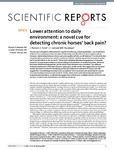Lower attention to daily environment: a novel cue for detecting chronic horses' back pain?
| dc.contributor.author | Rochais, C | en |
| dc.contributor.author | Fureix, C | en |
| dc.contributor.author | Lesimple, C | en |
| dc.contributor.author | Hausberger, M | en |
| dc.date.accessioned | 2017-12-12T18:04:46Z | |
| dc.date.available | 2017-12-12T18:04:46Z | |
| dc.date.issued | 2016-01-29 | en |
| dc.identifier.uri | http://hdl.handle.net/10026.1/10415 | |
| dc.description.abstract |
Chronic pain is thought to affect patients' cognitive functioning, including attention. Loss of attention is likely to have an impact on the execution of daily tasks, and, therefore, to have negative effects. However, relationships between chronic pain and cognitive deficits are still debated. Pre-clinical studies using laboratory animals prove useful to model pain-related cognitive impairment, but animal models had to predict effects in the real world. This study investigates attentional engagement of domestic horses by comparing observations in a home setting and evaluations of vertebral disorders. We found that lower attentional engagement and the level of back disorders were correlated. Two different evaluation techniques of the state of horses' spines gave similar results. We suggest that novel animal models would prove useful for identifying spontaneous behaviours indicative of chronic pain. We suggest that more ethological studies in human patients' home environments would help to improve our understanding of the processes involved. Finally, these results yield interesting indications for evaluating animal welfare, as attentional engagement could become a reliable indicator of chronic pain and thus a useful tool for identification of suffering individuals. | en |
| dc.format.extent | 20117 - ? | en |
| dc.language | eng | en |
| dc.language.iso | eng | en |
| dc.subject | Animals | en |
| dc.subject | Back Pain | en |
| dc.subject | Chronic Pain | en |
| dc.subject | Female | en |
| dc.subject | Horse Diseases | en |
| dc.subject | Horses | en |
| dc.subject | Humans | en |
| dc.subject | Male | en |
| dc.title | Lower attention to daily environment: a novel cue for detecting chronic horses' back pain? | en |
| dc.type | Journal Article | |
| plymouth.author-url | https://www.ncbi.nlm.nih.gov/pubmed/26823123 | en |
| plymouth.volume | 6 | en |
| plymouth.publication-status | Published online | en |
| plymouth.journal | Sci Rep | en |
| dc.identifier.doi | 10.1038/srep20117 | en |
| plymouth.organisational-group | /Plymouth | |
| plymouth.organisational-group | /Plymouth/Faculty of Science and Engineering | |
| plymouth.organisational-group | /Plymouth/REF 2021 Researchers by UoA | |
| plymouth.organisational-group | /Plymouth/REF 2021 Researchers by UoA/UoA04 Psychology, Psychiatry and Neuroscience | |
| dc.publisher.place | England | en |
| dcterms.dateAccepted | 2015-12-29 | en |
| dc.identifier.eissn | 2045-2322 | en |
| dc.rights.embargoperiod | Not known | en |
| rioxxterms.versionofrecord | 10.1038/srep20117 | en |
| rioxxterms.licenseref.uri | http://www.rioxx.net/licenses/all-rights-reserved | en |
| rioxxterms.licenseref.startdate | 2016-01-29 | en |
| rioxxterms.type | Journal Article/Review | en |


